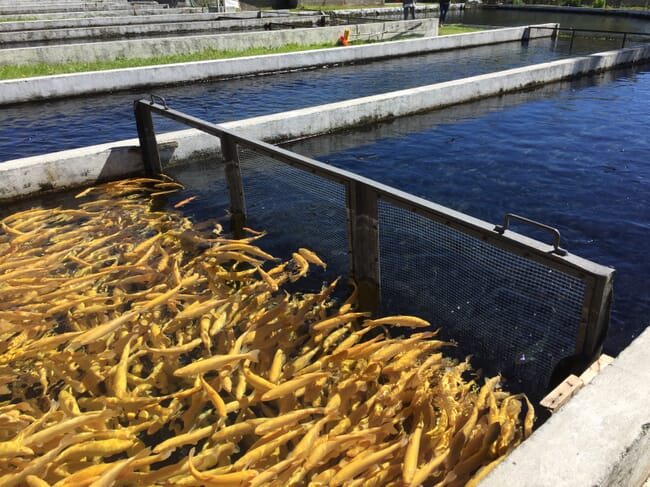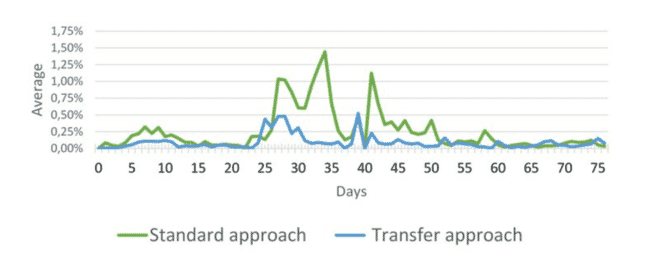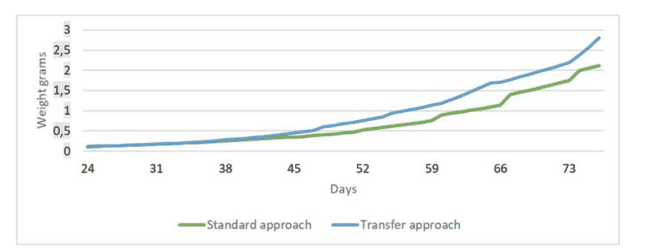
Fish farmers should account for the behaviour of their stocks when implementing feed strategies.
After hatching and in the first feeding, larger farmed trout typically crowd out the smaller ones. To address this challenge and ensure all fish can access feed, researchers suggest that first feeding strategies consider the fry’s behaviour. A recent article from Troutlodge outlines a success story from a farm in Peru that is making improvements in its feed management protocols.
The Truchas Arapa company in the region of Puno, Peru, decided to run a trial in feeding management – keeping the territorial behaviour of larger trout in mind. Usually in the re-incubation and fry room, the first feeding begins when 80 percent of the fry have reabsorbed their yolk sacs. However, the downside of this strategy is that when the stronger trout wait longer for feed, their genetic potential is negatively impacted and they may struggle to reach optimum growth over their life span. For better results, they decided to trial a new approach where the fry are moved to another production unit as soon as they reabsorb the yolk sac to start the first feeding. With this change, the fry have the opportunity to feed as soon as needed without waiting for the others to reabsorb the sac.
In this context, two first feeding strategies were tested during the first 49 days that the Troutlodge fry learned to eat. These were:
- Separate the stock of fingerlings that have finished reabsorbing their sack from the rest. The density reached up to 180 fingerlings/Lt. Troutlodge called this the transfer approach.
- Wait for 80 percent of the fry to reabsorb their yolk sac and start feeding at a density of 120 fry/Lt. This was the standard approach.
The eggs were re-incubated in vertical systems. For the first feeding, fiberglass troughs were used. The average daily temperature was 12˚C. The average water flow at entry was 1.5 Lt/min/1,000 fingerlings.
“It’s always somewhat daunting to try something new in your operations. But with the support and guidance from the Troutlodge team, we decided to take the risk. In the end, we are very pleased with the results from the trial and have gained some important insights in achieving success in the first days of hatching,” the Truchas Arapa team said.
The transfer approach
A trough and seven baskets were used to transfer the fry. The fry that finished reabsorbing their yolk sac and started to float in the vertical incubators were transferred to the Californian system to start the first feeding.
The standard approach
The trough with the same dimensions, but without baskets, was used. The team waited for 80 percent of the fry to finish reabsorbing their yolk sacs before transferring all of them to the troughs and start their first feeding. In both cases, the team used the maximum allowable water depth in the troughs.
Measured production indicators
The evaluation was carried out over 76 days from the re-incubation of eggs. The team compared the daily mortality rate, accumulated mortality and average weight between the two groups as their key production indicators.
Key results:
Daily mortality
As expected, the percentage of daily mortality increased during the hatching process and a few days after the trout started feeding. Daily mortality was similar during the hatching stage, however, it began to differ from the beginning of first feeding. The Troutlodge team thought this could be due to the feeding strategy. In the transfer approach, a more uniform feed capture, lower percentage of unconsumed feed and fewer pinhead fry were observed. The increase in daily mortality in the standard approach is most likely due to starvation of the smaller fry.

© Troutlodge
Feeding began 24 days after re-incubation of eggs. From the first day of feeding to day 50, a great difference in daily mortality was observed between both strategies. From day 24 to day 76, the follow-up period showed 88 percent more mortality in the standard approach compared to the transfer approach.
Accumulative mortality
From day 28, significant differences became more apparent, the transfer approach had 46 percent less accumulated mortality than the standard approach. “The difference at day 76 is undeniable,” Troutlodge commented.

© Troutlodge
Average weight
The graph shows the weekly average weight since the start of feeding. Results showed that from the third week, there was a difference in average weights. With the transfer approach, at day 44, 23.5 percent more in weight was achieved than with the standard approach. At day 76, the difference was 33.3 percent.
The difference in average weight is likely because the fingerlings from the transfer approach were fed on time and did not lose their growth potential by waiting for the rest of the fingerlings to start feeding.

© Troutlodge
Final insights
First feeding strategies play a vital role in trout production. This is reflected in the production indicators. Moving the fry and starting primary feeding when it is first required allows facilitates the best use of feed. In addition, it improves the survival of the biomass. These results show that an adapted feeding strategy can have a significant impact on unlocking genetic potential and getting the most value in trout operations.




